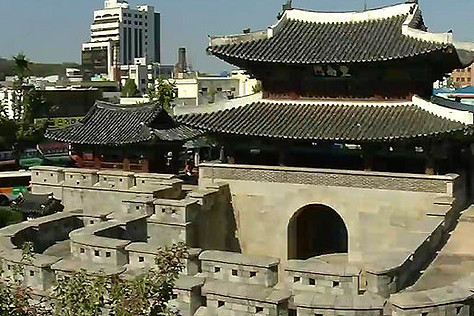Jeonju Hanok Village Tour by KTX Express train

Take a 1 hour and 36-minute KTX train ride from Seoul, traveling at 300 km/h, to visit Jeonju, a city known for its charming and relaxed atmosphere, Jeonju Hanok Village, and delicious Jeonju bibimbap. This tour includes a visit to Jeonju Hanok Village and an experience making traditional Korean paper.
Most tourist attractions in Jeonju are located in the Hanok Village, including the Gyeonggijeon Shrine, Jeonju Hyanggyo Confucian School, a traditional Korean paper factory, and Pungnammun Gate. It's a great place for a weekend or day trip from Seoul, and in the evening, you'll take a KTX train back to Seoul.
<Tour description>
Jeonju Hanok Village
_edited%20(1).jpg)
Jeonju Hanok Village, the largest Hanok village in Korea, features about 700 Hanok houses clustered together, As the cradle of the Joseon Dynasty, this place has a wide range of cultural resources and historical values. Visitors can see many attractions such as Gyeonggijeon and Omokdea, tracing the history from Joseon Dynasty to the modern-day. The cultural activities and the food provided add to the traditional ambiance. Jeonju Hanok village is the most popular landmark and a must for tourists.
Omokdae Pavilion
.jpg)
Omokdae is one of the places where Yiseong-gye, the founder of the Joseon dynasty stopped to celebrate his victory on his way home from a battle with Japanese invaders at Hwangsan, Namwon in 1380(the 6th year of Kong Woo of Goryeo Dynasty). It offers a stunning view of Jeonju's Hanok Village.
Gyeonggijeon Shrine

Historic Site No. 339, Gyeonggijeon Shrine was erected in 1410 and holds the portrait of King Tae-jo, the founder of the Joseon Dynasty. And features monuments such as a jogyeongmyo, jeonju Sago(Historical Archives), Taesil(the placenta chamber). The wide bamboo forest trail and huge trails in the precincts are good for taking a walk. It is well preserved as a location for historical drama and movie filming.
Jeondong Catholic Cathedral
.jpg)
Jeondong Catholic Church in Jeonju (Historic Site No. 288) was built in honor of Roman Catholic martyrs of the Joseon Dynasty on the very same spot the martyrs lost their lives.
Pungnammun Gate and Nambu market

Pungnammun Gate was built in the middle of the Joseon Dynasty (1768) and was designated Treasure No. 308. Of the four original city gates, this is the only one left standing (located in the southern portion of the city).
Nambu Market is right next to Pungnammun Gate
Over 200 years old, Nambu Market is the oldest major market in Jeonju. Visitors not only can enjoy delicious foods but also can see a variety of interesting attractions.
Hanji Making experience

Jeonju Jeontong Hanjiwon sells various types of Hanji(Korea's traditional paper) from the ones for calligraphy, oriental painting, and crafts. Aside from its functionality, Hanji itself has beautiful colors so it is almost an artwork. This place is not just a Hanji shop but it a workshop where people can experience how to make Hanji.
Enjoy making Korea's traditional paper in this traditional town.
Jeonju Hyanggyo Confucian school

A hyanggyo is the Joseon Dynasty’s local Confucian school. Since Goryeo Dynasty (918-1329). It had been installed as the public educational institution in provinces. Therefore, Hyanggyo is likened to today’s national universities installed in major regional cities. The sheer size and the golden aura of the gingko trees are overwhelming. All Hyanggyos in Korea planted gingko trees. Because gingko trees have a long lifespan and chase off bugs, Koreans planted the trees wishing that the students concentrate on studying and become great names for the country.
<Tour itinerary>

Seoul
Jeonju
08:00 Pick up
08:40 Take KTX train to Jeonju
10:15 Meet a guide at Jeonju station
Head to Jeonju Hanok village
Hanji making experience
Gyeonggijeon shirine
Omokde pavillion
Mural village
Jeonju Hyanggyo
18:00 Take KTX train Back to Seoul
19:40 Arrive at Yongsan station (Seoul)
20:00 Drop off Hotel
<Price for persons>
<Inclusions>
-
1Day private tour
-
All admission fees to tourists sites
-
Professional English-speaking guide
-
Roundtrip transfer service with private vehicle (Jeonju City)
-
KTX round trip fare (Economy class)
-
Hotel Pick-up & Drop off service
<Exclusions>
-
Personal expenses
-
Every Meal
-
Gratuities
<Please note>
-
The hotel pick-up time varies depending on your hotel's location.
%20(2).png)